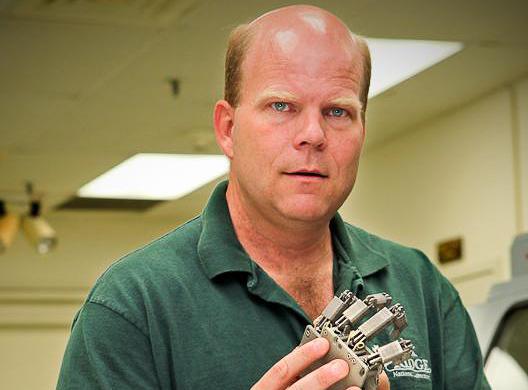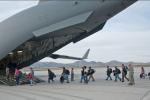
Dr. Lonnie Love | Photo Courtesy of ORNL
In the latest 10 Questions, meet Oak Ridge National Laboratory engineer Lonnie Love. From mesofluidics and hydraulics to solar photovoltaics and biogeneration, Dr. Love discusses his innovative approaches to advancing robotics, clean energy technology and nanomaterials. Get an insider’s look at all this and more below:
Question: Why did you pursue a career in science?
Lonnie Love: When I was a kid, I loved to figure out how things worked. One memory that’s vivid is taking apart my dad’s lawn mower and not being able to get it back together before he got home. His response was “You should be an engineer.” I was young enough that I didn’t know what that was. But, if I could take apart someone’s stuff and not get in trouble…that was the job for me!
Q: Your work focuses on robotics engineering and biogeneration – what led you to this position?
LL: I think life is about opportunities. When I was an undergraduate, I had an opportunity to work in a controls lab. It was my first exposure to robotics. This led to an internship at NASA Langley which was a springboard for my Ph.D. and career with ORNL’s Robotics Group.
Q: Can you tell us about your work with mesofluidics and hydraulics?
LL: When I came to ORNL in 1995, R&D in hydraulics had been stagnant since the late 1960’s. My group began by focusing on the design and control of strength amplifying machines which required hydraulics. It was really good work, fun and exciting. In 2004, we asked a simple question: how well does hydraulics scale to smaller systems? It turns out that hydraulics scale beautifully. This led to the work in mesofluidics: miniaturized hydraulics. We’ve applied the technology to a number of robotic, prosthetic and wearable robotic applications.
Q: What other projects are you working on right now? What do you hope they will lead to?
LL: An exciting new area that dovetails perfectly with my work in hydraulics is additive manufacturing – building parts up from powders rather than machining away material. While additive manufacturing has been around for over 20 years, it’s undergoing a new transition in the area of metals, moving towards real parts on top of the traditional prototyping market. What’s really exciting is blending hydraulics with this manufacturing process.
Complexity is free so we’re designing systems that are extremely lightweight, highly integrated, blending the hydraulic actuation and fluid with the structure. It’s a lot like nature. But, most importantly, these systems can be extremely inexpensive. My hope is that this technology will lead to a new age of low-cost, disposable robotics.
Q: How does your work in biogeneration impact solar photovoltaics?
LL: This is a real exciting project – gets to the essence of what I love about working at a National Lab. In 2000, I was exploring ferrofluids, liquids loaded with nanometer sized magnetic particles. I ran into a big problem. It was very difficult to mass produce the materials. By chance, I met an ORNL microbiologist, Tommy Phelps. During one conversation with Tommy, I describe the project and his response was, “I have bacteria that produce massive quantities of magnetic nanoparticles.”
This brief conversation has led to a series of programs focusing on bacterial synthesis of nanomaterials, what we call nanofermentation. In nature, the bacteria typically convert iron salts in their environment to magnetite. In 2006, one of our chemists, Adam Rondinone, asked if the bacteria could live in a sulfur rich environment. We set up some experiments and before long the bacteria were producing cadmium sulfide and zinc sulfide, semiconductive materials. Craig Blue and Ron Ott, ORNL material researchers, asked if the bacteria could synthesize CIGS (aka copper indium gallium selenide), an attractive material for thin film photovoltaics. After a few months of testing, we were successful. We’re now attempting to use the material for low-cost solar cells. Our hope is that this is a low-cost, scalable process to make nanomaterials for a broad spectrum of applications.
Q: What projects/research are you watching (besides your own)?
LL: Anything to do with the mass production and efficient use of energy. I really believe that energy is the foundation of our economy. It controls how much things cost to manufacture as well as transport. It’s a really difficult problem – providing massive amounts of energy to a broad spectrum of consumers at a low price. I read a great book by Maury Klein called The Power Makers. It gave me a deep appreciation for the power industry and its ability to provide energy at such a massive scale. We never appreciated energy and how available and inexpensive it is until something happens and it’s gone.
Q: Do you have advice for students interested in science and engineering careers?
LL: Get active! Build stuff, make stuff, break stuff. There are lots of opportunities to get experience and see if a career in science or engineering is something you’d enjoy. This year I helped a local school on their FIRST robotics team. What an amazing experience! For six weeks high school kids took a box of parts and converted it into a working robot.
The coolest moment was when we met back at the school and I realized they didn’t have a shop. But they did have a 3D printer! I spent a day and taught three kids CAD (computer-aided design) and had them printing parts for their robot. It was a real “ah-ha!” moment.
I really believe kids interested in engineering and science need to be building things. I also believe additive manufacturing can really reinvigorate U.S. manufacturing. What an amazing opportunity to introduce fresh young engineers to what could be the future of manufacturing! This process takes a fresh perspective in terms of design. Who better to lead the way than young engineers not encumbered by experience! I’m mentoring those same three kids at ORNL next year for their senior portfolio. Education is much more than class work – also try to find a mentor, someone to give you meaningful and honest advice. I’ve been blessed by having some of the best.
Q: What is your favorite tool in the lab?
LL: My favorite tool is my Leatherman. My brother-in-law gave me my first one in 1990. I guess it was a trade. “Lonnie, you take my sister, I’ll give you a Leatherman!” It was a win-win for me.
Q: What can you never start a day at the lab without?
LL: Coffee is always a must. But, really, I have a few engineers that I love meeting with to get my day going. Randy Lind is probably my favorite – he’s always finding some odd ball technology or interesting history of technology to talk about.
Q: Last question – what is a hobby of yours outside of the lab?
LL: I’m not sure if you could say it’s a hobby, but I like working with kids – high school kids mostly. It’s an amazing stage in life, trying to decide who you are and what you want to do with your life. As a scientist, it’s a great opportunity to help guide some of these kids. Sometimes you can make a difference.





